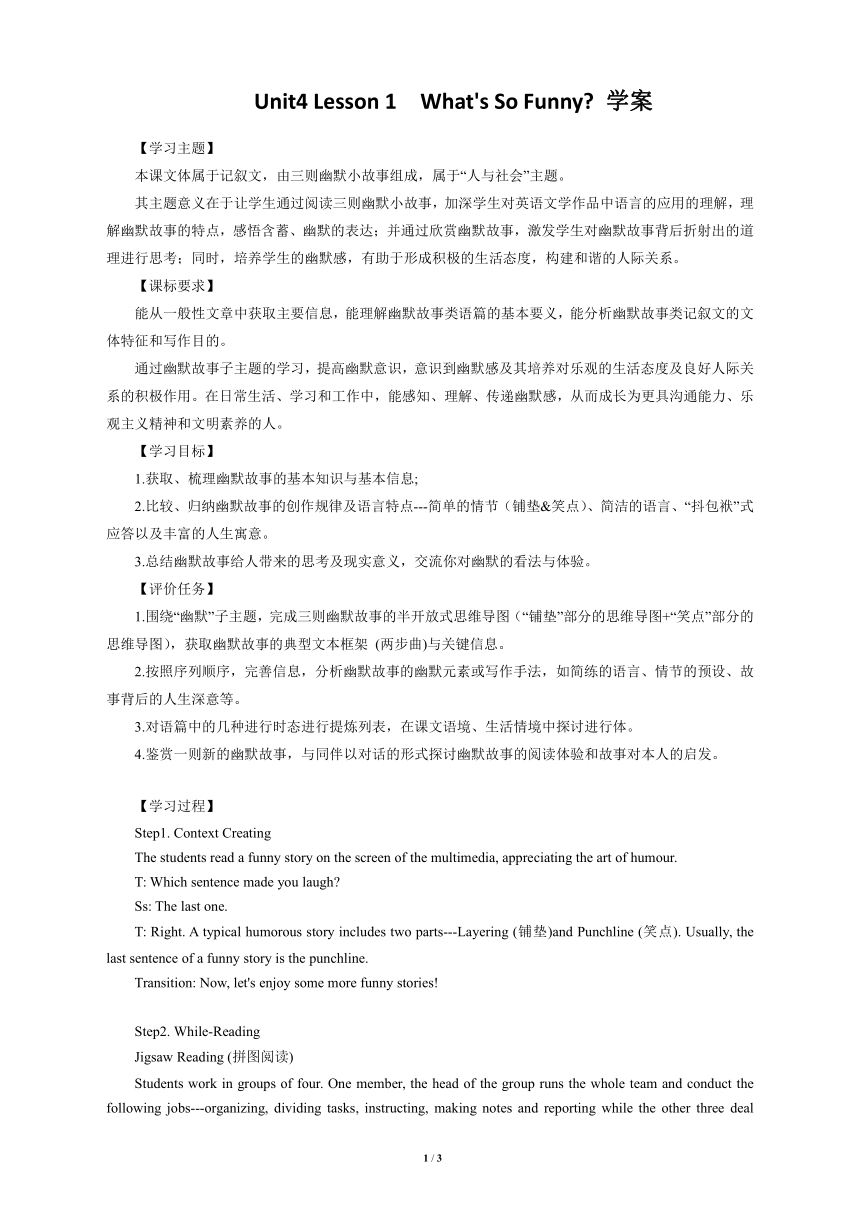北师大版(2019)高中英语选择性必修第二册 Unit 4 Humour Lesson 1 What’s So Funny优质教案4
文档属性
| 名称 | 北师大版(2019)高中英语选择性必修第二册 Unit 4 Humour Lesson 1 What’s So Funny优质教案4 |

|
|
| 格式 | docx | ||
| 文件大小 | 18.0KB | ||
| 资源类型 | 教案 | ||
| 版本资源 | 北师大版(2019) | ||
| 科目 | 英语 | ||
| 更新时间 | 2023-03-16 15:24:01 | ||
图片预览

文档简介
Unit4 Lesson 1 What's So Funny 学案
【学习主题】
本课文体属于记叙文,由三则幽默小故事组成,属于“人与社会”主题。
其主题意义在于让学生通过阅读三则幽默小故事,加深学生对英语文学作品中语言的应用的理解,理解幽默故事的特点,感悟含蓄、幽默的表达;并通过欣赏幽默故事,激发学生对幽默故事背后折射出的道理进行思考;同时,培养学生的幽默感,有助于形成积极的生活态度,构建和谐的人际关系。
【课标要求】
能从一般性文章中获取主要信息,能理解幽默故事类语篇的基本要义,能分析幽默故事类记叙文的文体特征和写作目的。
通过幽默故事子主题的学习,提高幽默意识,意识到幽默感及其培养对乐观的生活态度及良好人际关系的积极作用。在日常生活、学习和工作中,能感知、理解、传递幽默感,从而成长为更具沟通能力、乐观主义精神和文明素养的人。
【学习目标】
1.获取、梳理幽默故事的基本知识与基本信息;
2.比较、归纳幽默故事的创作规律及语言特点---简单的情节(铺垫&笑点)、简洁的语言、“抖包袱”式应答以及丰富的人生寓意。
3.总结幽默故事给人带来的思考及现实意义,交流你对幽默的看法与体验。
【评价任务】
1.围绕“幽默”子主题,完成三则幽默故事的半开放式思维导图(“铺垫”部分的思维导图+“笑点”部分的思维导图),获取幽默故事的典型文本框架 (两步曲)与关键信息。
2.按照序列顺序,完善信息,分析幽默故事的幽默元素或写作手法,如简练的语言、情节的预设、故事背后的人生深意等。
3.对语篇中的几种进行时态进行提炼列表,在课文语境、生活情境中探讨进行体。
4.鉴赏一则新的幽默故事,与同伴以对话的形式探讨幽默故事的阅读体验和故事对本人的启发。
【学习过程】
Step1. Context Creating
The students read a funny story on the screen of the multimedia, appreciating the art of humour.
T: Which sentence made you laugh
Ss: The last one.
T: Right. A typical humorous story includes two parts---Layering (铺垫)and Punchline (笑点). Usually, the last sentence of a funny story is the punchline.
Transition: Now, let's enjoy some more funny stories!
Step2. While-Reading
Jigsaw Reading (拼图阅读)
Students work in groups of four. One member, the head of the group runs the whole team and conduct the following jobs---organizing, dividing tasks, instructing, making notes and reporting while the other three deal members the three.
1.Literal Reading
What is the text mainly about
1)Complete the half-open mind map of each story to extract the basic structure and key information of the article.
Story A
Part1---Paras1~6
Part2---Para.7
Story B
Part1---Paras1~5
Part2---Para.6
Story C
Part1---Paras1~5
Part2---Para.6
2.Interpretive Reading
How to achieve humor
1)Language (语言使用)
Simplified (简洁)?
Complicated (复杂)
2)Plot (情节预设)
A._______________________________________
B._______________________________________
C._______________________________________
......
3)Continuous Tenses
进行时态的使用
A._______________________________________
B._______________________________________
C._______________________________________
Question:
Why are Continuous Tenses are commonly used in a funny story
4)Meanings behind the story
(大笑背后的深层意义)
Story A:
______________________________________
Story B:
_______________________________________
Story C:
_______________________________________
3.Critical Reading
1)What's the value of humour
A. ______________________________________
B._______________________________________
C._______________________________________
2)Do you want to be a humorous person, why and how
Step3. Post-reading
Pair work
Playing a game called Mystery Envelope.
2人一小组,做神秘信封游戏。
学生与同伴抽取英语教师提供的信封,信封内包含一则英文幽默小故事,故事版本共3-4个。
Task1
Appreciate the funny story with your partner.
Task2
Make a dialogue to share the acquisition and inspiration you get from the story.
a dialogue on the funny story
A:
B:
A:
B:
A:
B:
A:
B:
A:
B:
A:
B:
Step4. Homework
Read more articles featuring humor and raise sense of humour.
【教学反思】
◎Can the students appreciate a funny story skillfully now
◎Are the students aware of the value of being humorous
2 / 2
【学习主题】
本课文体属于记叙文,由三则幽默小故事组成,属于“人与社会”主题。
其主题意义在于让学生通过阅读三则幽默小故事,加深学生对英语文学作品中语言的应用的理解,理解幽默故事的特点,感悟含蓄、幽默的表达;并通过欣赏幽默故事,激发学生对幽默故事背后折射出的道理进行思考;同时,培养学生的幽默感,有助于形成积极的生活态度,构建和谐的人际关系。
【课标要求】
能从一般性文章中获取主要信息,能理解幽默故事类语篇的基本要义,能分析幽默故事类记叙文的文体特征和写作目的。
通过幽默故事子主题的学习,提高幽默意识,意识到幽默感及其培养对乐观的生活态度及良好人际关系的积极作用。在日常生活、学习和工作中,能感知、理解、传递幽默感,从而成长为更具沟通能力、乐观主义精神和文明素养的人。
【学习目标】
1.获取、梳理幽默故事的基本知识与基本信息;
2.比较、归纳幽默故事的创作规律及语言特点---简单的情节(铺垫&笑点)、简洁的语言、“抖包袱”式应答以及丰富的人生寓意。
3.总结幽默故事给人带来的思考及现实意义,交流你对幽默的看法与体验。
【评价任务】
1.围绕“幽默”子主题,完成三则幽默故事的半开放式思维导图(“铺垫”部分的思维导图+“笑点”部分的思维导图),获取幽默故事的典型文本框架 (两步曲)与关键信息。
2.按照序列顺序,完善信息,分析幽默故事的幽默元素或写作手法,如简练的语言、情节的预设、故事背后的人生深意等。
3.对语篇中的几种进行时态进行提炼列表,在课文语境、生活情境中探讨进行体。
4.鉴赏一则新的幽默故事,与同伴以对话的形式探讨幽默故事的阅读体验和故事对本人的启发。
【学习过程】
Step1. Context Creating
The students read a funny story on the screen of the multimedia, appreciating the art of humour.
T: Which sentence made you laugh
Ss: The last one.
T: Right. A typical humorous story includes two parts---Layering (铺垫)and Punchline (笑点). Usually, the last sentence of a funny story is the punchline.
Transition: Now, let's enjoy some more funny stories!
Step2. While-Reading
Jigsaw Reading (拼图阅读)
Students work in groups of four. One member, the head of the group runs the whole team and conduct the following jobs---organizing, dividing tasks, instructing, making notes and reporting while the other three deal members the three.
1.Literal Reading
What is the text mainly about
1)Complete the half-open mind map of each story to extract the basic structure and key information of the article.
Story A
Part1---Paras1~6
Part2---Para.7
Story B
Part1---Paras1~5
Part2---Para.6
Story C
Part1---Paras1~5
Part2---Para.6
2.Interpretive Reading
How to achieve humor
1)Language (语言使用)
Simplified (简洁)?
Complicated (复杂)
2)Plot (情节预设)
A._______________________________________
B._______________________________________
C._______________________________________
......
3)Continuous Tenses
进行时态的使用
A._______________________________________
B._______________________________________
C._______________________________________
Question:
Why are Continuous Tenses are commonly used in a funny story
4)Meanings behind the story
(大笑背后的深层意义)
Story A:
______________________________________
Story B:
_______________________________________
Story C:
_______________________________________
3.Critical Reading
1)What's the value of humour
A. ______________________________________
B._______________________________________
C._______________________________________
2)Do you want to be a humorous person, why and how
Step3. Post-reading
Pair work
Playing a game called Mystery Envelope.
2人一小组,做神秘信封游戏。
学生与同伴抽取英语教师提供的信封,信封内包含一则英文幽默小故事,故事版本共3-4个。
Task1
Appreciate the funny story with your partner.
Task2
Make a dialogue to share the acquisition and inspiration you get from the story.
a dialogue on the funny story
A:
B:
A:
B:
A:
B:
A:
B:
A:
B:
A:
B:
Step4. Homework
Read more articles featuring humor and raise sense of humour.
【教学反思】
◎Can the students appreciate a funny story skillfully now
◎Are the students aware of the value of being humorous
2 / 2
同课章节目录
- Unit 4 Humour
- Lesson 1 What’s So Funny?
- Lesson 2 Why Do We Need Humour?
- Lesson 3 My Favourite Comedian
- Unit 5 Education
- Lesson 1 Enlightening a Mind
- Lesson 2 The Objectives of Education
- Lesson 3 Understanding
- Unit 6 The Media
- Lesson 1 From Page to Screen
- Lesson 2 Questions about Media
- Lesson 3 The Advertising Game
